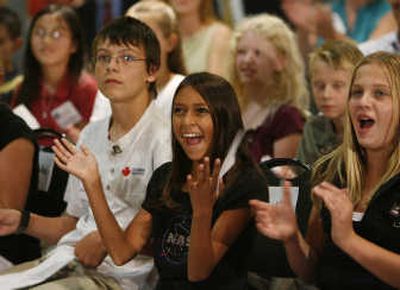Teacher holds class in space

BOISE – Her long, dark hair floating wildly around her head, teacher-astronaut Barbara Morgan was clearly in her element as she fielded questions in space Tuesday from 18 Idaho schoolchildren gathered at a Boise science museum.
When Jordan Hill, of Rigby, asked about weightlessness, Morgan let one of her fellow astronauts answer the question while she floated in a slow somersault in midair, smiling.
And when Elisha Mabey, of Ririe, asked about challenges in manipulating a robotic arm that’s among Morgan’s key duties on the space shuttle Endeavour, Morgan cited Newton’s third law of motion: For every action, there’s an equal and opposite reaction.
“When I push the arm down, look what happens to my body: it pushes me up,” she said, pushing down with her arms as the entire rest of her body floated gracefully upward. The challenge, she noted, is to keep herself very steady while operating the equipment.
Morgan, the former McCall, Idaho, schoolteacher who’s waited to go into space for the past 22 years, is now at the International Space Station 200 miles above Earth, where she’s playing a key role in helping to assess damage to tiles on the shuttle as NASA officials mull repairs. But she took time out from that work Tuesday, along with three fellow crew members, to talk for 25 minutes with Idaho schoolchildren.
“It was just really cool to be able to talk to Barbara Morgan and her crewmates,” said Z.J. Mayton, a sixth-grader from Lewiston.
Gavin Tosten, who’s almost 12, said he figures he’s now the only person from Grangeville, Idaho, who’s talked directly to people in outer space. “It was very cool,” he said.
Greg Pitzer, a NASA education specialist who helped man a special NASA display at the Discovery Center of Idaho science museum on Tuesday, said downlinks with the International Space Station aren’t that unusual, but they’re rare when it comes to space shuttle missions. “Generally, the shuttle missions are pretty tightly packed for time,” he said. “This mission is obviously very important because of Barbara Morgan. … She wanted to talk to the students here in Idaho.”
Morgan was the backup in 1986 for the nation’s first designated “Teacher in Space,” Christa McAuliffe. The two trained together for the mission. But the space shuttle Challenger exploded shortly after liftoff, killing McAuliffe and the other crew members.
Morgan returned to teaching elementary school in McCall while continuing to work with NASA, and then in 1998 she signed on to become a fully trained astronaut.
Sarah Blum, a ninth-grader from Moscow, Idaho, asked Morgan how being a teacher related to her work on the mission as an astronaut.
“Astronauts and teachers actually do the same thing,” Morgan responded. “We explore, we discover and we share. And the great thing about being a teacher is you get to do that with students, and the great thing about being an astronaut is you get to do it in space. And both are absolutely wonderful jobs.”
The kids quizzed Morgan and astronauts Clay Anderson, Alvin Drew and Dave Williams on everything from the speed of a baseball thrown in space (very, very slow, as the astronauts demonstrated), to how astronauts exercise in space to prevent bone loss. After Anderson demonstrated an in-flight stationary bike, the petite, laughing Morgan showed how she could reach right out and lift up Drew and Williams – her two larger male colleagues – with just one hand each.
The astronauts also clowned around with blobs of red liquid floating through the air after the kids asked for a demonstration on how they drink liquids in space.
“It was really interesting seeing them up there and just talking to them,” said Cosette Roberts, of Kellogg. “They were totally weightless. They were bouncing around.”
The youngsters who questioned the astronauts were selected by their science teachers. Roberts said her third-grade teacher from Sunnyside Elementary School recommended her to her science teacher, in part, she figures, because she’s acted in a melodrama theater production. “She knew I wasn’t bad in front of a crowd, so she knew I would be able to do it,” the youngster said.
Two other downlinks are tentatively scheduled for Virginia and Massachusetts later in the mission, but Pitzer said it’ll depend on how the mission goes. Initially, those sessions were to be held if the space shuttle successfully hooked up to the International Space Station’s power system, which it did, allowing the mission to be extended by three days. But, he said, “Now, with the possible shuttle tile repairs, that could throw a wrench into the plans.”
Before the downlink started, Idaho first lady Lori Otter, a former teacher, presented a proclamation from the governor declaring “Idaho Reaches Into Space Month.” She said, “I can just say as a teacher, this is way cool!”
U.S. Sen. Mike Crapo said anyone seeing what’s happening in the U.S. space program would want it to continue. “I’ll be a strong voice for it,” he said.
Dottie Metcalf-Lindenburger, another NASA astronaut and a candidate to be a future educator-astronaut like Morgan, signed autographs and posed for pictures with the kids before the downlink. Metcalf-Lindenburger said she expects that in the future, space travel will become much more common than it is now.
She told the crowd, “I would hope that someday, a lot of us would go into space.”